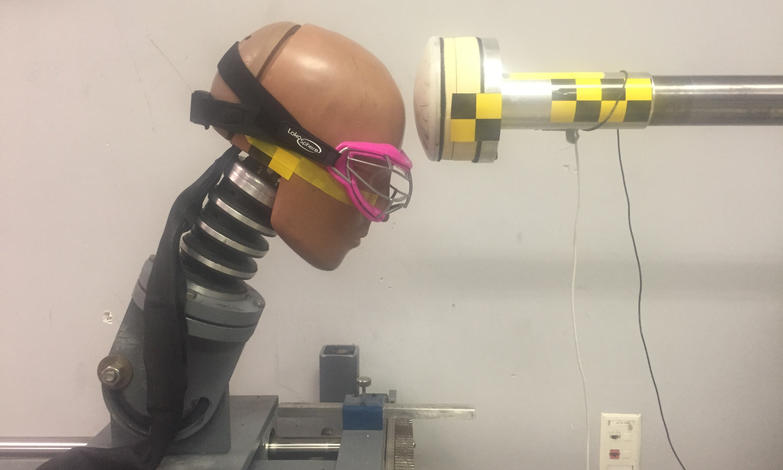
When Assistant Professor of Mechanical Engineering Amanda Esquivel began planning her recent study comparing head acceleration in boys and girls lacrosse players, she knew one of her first challenges would involve a basic engineering problem. Unlike their male counterparts, female lacrosse players don’t wear helmets. So that quickly ruled out using the established helmet-mounted sensor systems that have already been developed to study head impacts in football players.
Instead, she bought a headband-mounted system that the athletes could strap on with their protective goggles — which sounds like a simple enough fix. Except that in using a different sensor, which hadn’t been called into research service in this way before, her team had to properly validate it so they could get the kind of data they were after. “When you mount a sensor in a helmet or headband, what you're really measuring is what’s going on in the helmet or headband— not what’s going on in the center of the head,” Esquivel explains.
To get around that problem, they first equipped the head of a crash test dummy with the headband-mounted sensors as well as a second set of sensors at the head’s center. The team then subjected the dummy to all kinds of impacts. Finally, using a little mathematical modeling, they correlated the information from the two sensors — so the data coming from the outside would be a decent stand-in for the inside.

Even then, Esquivel says this kind of modeling “isn’t perfect.” And she’s quick to point out that even once you’ve gone to all the trouble of validating the sensors and collecting data on real athletes, you’ve still only managed to lay a few bricks in the wall researchers are ultimately hoping to build. That, of course, is determining the effects of such impacts on our brains, and eventually, establishing some prescriptive thresholds for athletes.
Such is the nature of sports injury research today, in which many big conclusions could still be decades off and breakthroughs are more likely to occur cumulatively in small pieces rather than big dramatic leaps. Still, wearable sensors could prove to be a field-changing innovation. Compared with football, which has a body of research now spanning 20 years, Esquivel says helmetless sports, women’s sports and youth sports are underexplored territory, and the new technology could allow researchers to tackle all kinds of significant questions. “The important thing to remember is that even if we were able to draw conclusions from what we’ve learned from 20 years of studying adult male football players, that still wouldn't necessarily tell us everything we need to know about, say, men’s soccer players or women’s lacrosse players — or kids playing the same sports.”
In addition to expanding study into other sports, the wearable technology could help researchers explore a broader range of sports injuries. For example, one of Esquivel’s latest projects is a collaboration with U-M Mechanical Engineering Research Professor James Ashton-Miller, who’s studying one of the more common catastrophic knee injuries in sports. Up until now, she says it’s often been assumed that ACL tears are an acute injury, caused by a single severe event that damages the ligament. But in research with cadavers, Ashton-Miller demonstrated that ACL tears can sometimes result from cumulative loading on a ligament.
Now, Esquivel and Ashton-Miller are preparing a study that would use the wearable sensor system to examine the same questions on live athletes. “You can’t simply extrapolate from what you see on cadavers to what you see in live people, because the body is always repairing itself,” Esquivel says. “But if we did observe a similar phenomenon, our goal would be to figure out what a dangerous loading cycle would be for an ACL, and possibly even identify actions or movements that are specifically contributing to these types of loads.”
If, through this new study, they were able to draw conclusions about that, it could ultimately be used as the basis of an early warning system that gives athletes a heads up to rest and recoup; or it could simply help coaches and trainers minimize movements in practice that may cause overuse ACL injuries.
Such a breakthrough, Esquivel says, would still be a few steps away. But in a field where the headline conclusions are earned one small study at a time, each step, by its nature, counts as one in the right direction.




